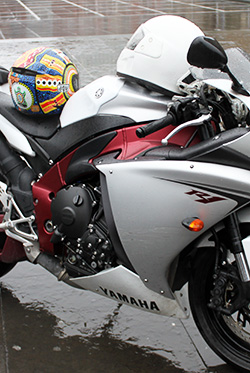 At the European Parliament in Strasbourg MEPs voted yesterday, 11th March 2014 and accepted the deal with member states on minimum common standards for periodic vehicle inspections, vehicle registration documents and roadside inspections of commercial vehicles.
At the European Parliament in Strasbourg MEPs voted yesterday, 11th March 2014 and accepted the deal with member states on minimum common standards for periodic vehicle inspections, vehicle registration documents and roadside inspections of commercial vehicles.
We have been reporting on the original European Commission proposal for a regulation since 2010, which would have included mandatory Road Worthiness Testing for motorcycles in all member states.
Although in the UK we already have Road Worthiness Testing (MoT) for motorcycles some European countries do not.
One of those member states is the Netherlands and the rider’s organisation – MAG Netherlands – has been at the fore front against the inclusion of motorcycles in the RWT in the Netherlands and taking their objections directly to Brussels through lobbying and direct action by protesting.
The vote in the EU Parliament 557 (82%) For – Against 81 (12%) – Abstentions 43 (6%) endorsed the previously agreed compromises for motorcycles that: Exclude these vehicles from testing if they have put in place alternative effective road safety measures, taking into account in particular road safety statistics of the 5 years.
If heavy motorcycles are included in the scope of periodic roadworthiness testing, specific testing methods, inspection areas and frequency are decided at the Member State level.
For light motorcycles – within five years the Commission will submit to the European Parliament and the Council a report on the effectiveness of their possible inclusion in the scope of the directive.
In Strasbourg, MAG spokesman Dolf Willigers said: “This is a great victory for MAG and our European umbrella FEMA. Without close cooperation with our European sister organizations, MEPs and Corien Wortmann-Kool, Wim van de Camp and Peter van Dalen and the Dutch government, we would never have been able to achieve this result.”
FEMA (Federation of European Motorcyclists Associations) said on its Facebook page, “We won: no Euro bike inspections!”
The European Parliament News website said that, “Methods and frequency of motorcycle tests left up to member states. The Commission originally proposed having common testing requirements for motorcycles and mopeds. However, under the compromise agreed between the Council and Parliament, only motorcycles with engines over 125cc will be subject to compulsory inspections, and only from 2022 onwards. Moreover, member states may exempt them if they have “put in place effective alternative road-safety measures for two or three-wheel vehicles.”
Adding, “Member states can also impose stricter standards than those laid down in the rules if they wish.”
Provisional Text
 The provisional text adopted by the EU Parliament on Roadworthiness tests for motor vehicles and their trailers has also been published.
The provisional text adopted by the EU Parliament on Roadworthiness tests for motor vehicles and their trailers has also been published.
So delving into the details, the text says regarding motorcycles in the scope of the directive that, “from 1 January 2022, two- or three-wheel vehicles – vehicle categories L3e, L4e, L5e and L7e, with an engine displacement of more than 125 cm3 will be included.”
What the provisional text says is, “’two-or three-wheel vehicle’ means any power-driven vehicle on two wheels, with or without a sidecar, and any tricycle or quadricycle;”
Motorcycle categories are defined elsewhere as:
Category L3e vehicle (two-wheel motorcycle), sub-categorised by:
(i) motorcycle performance, further sub-categorised into:
– A1 vehicle (low-performance motorcycle);
– A2 vehicle (medium-performance motorcycle);
– A3 vehicle (high-performance motorcycle)
Category L4e vehicle (two-wheel motorcycle with side-car)
Category L5e vehicle (powered tricycle)
Category L7e vehicle (heavy quadricycles)
In Paragraph 2 of the text it says, “Member States may exclude the following vehicles registered in their territory from the scope of application of this Directive:
vehicles in categories L3e, L4e, L5e and L7e, with an engine displacement of more than 125 cm3, where the Member State has put in place effective alternative road safety measures for two- or three-wheel vehicles, taking into account in particular relevant road safety statistics covering the last five years. Member States shall notify such exemptions to the Commission.”
This is the text that allows member states who do not have Road Worthiness Testing not to introduce it for now.
It continues: “Member States may introduce national requirements concerning roadworthiness tests for vehicles registered in their territory which are not covered by the scope of this Directive and for vehicles listed in paragraph 2.”
The provisional text also says, “Member States shall establish appropriate intervals within which vehicles of categories L3e, L4e, L5e and L7e, with an engine displacement of more than 125 cm3, are to be subject to a roadworthiness test.
 If your country does not have Road Worthiness Testing for motorcycles then it can introduce testing – set intervals for testing or as here in the UK, continue as before.
If your country does not have Road Worthiness Testing for motorcycles then it can introduce testing – set intervals for testing or as here in the UK, continue as before.
The caveat to all of this and laid out in the provisional text is that:
“No later than … (five years from the date of publication of this Directive.), the Commission shall submit to the European Parliament and to the Council a report, based on independent studies, on the effectiveness of the inclusion of light trailers and two- or three-wheel vehicles in the scope of this Directive. The report shall assess the evolution of the road safety situation in the Union and, for each subcategory of L-vehicles, compare the results of national road safety measures, taking into account the average distance travelled by those vehicles. In particular, the Commission shall assess whether the standards and costs of periodic roadworthiness testing of each category of vehicle is proportionate to the road safety objectives set. The report shall be accompanied by a detailed impact assessment analysing the costs and benefits throughout the Union, including the specificities of Member States. The report shall be made available at least six months prior to the submission of any legislative proposal, if appropriate, to include new categories within the scope of this Directive.”
Thus if your country does not have Road Worthiness Testing for motorcycles and your rider organisation or government do not want it then they have some work ahead of them.
Even if your country has an improved “evolution of the road safety situation” other countries may not, thus if the European Commission is producing an overall report then just because your country has improved road safety for riders it doesn’t mean, our interpretation of the provisional text, that mandatory Road Worthiness Testing will not be introduced across Europe.
Also what the provisional text does not say is whether after five years (the submitted report says there is no need to make mandatory Road Worthiness Testing for motorcycles at that stage) another period of time will be introduced for another report.
It would seem to be inevitable that sometime, maybe in the distant future, that mandatory Road Worthiness Testing for motorcycles will be introduced European wide.
Riders may be sitting on a beach on a throne watching the waves from the incoming tide lap around their knees at the moment, unless rider organisations like MAG Netherlands who have the technical ability and the political ability to be informed and engage within the whole political process and be there when it matters for their riders in their country.
Some Small Print
 At present as we have outlined, member states are free to introduce or keep their Road Worthiness Testing for motorcycles.
At present as we have outlined, member states are free to introduce or keep their Road Worthiness Testing for motorcycles.
The provisional text again mentions motorcycles and says, “For vehicle categories L3e, L4e, L5e and L7e, with an engine displacement of more than 125 cm3, Member States shall determine the areas, items and appropriate methods of testing.”
Just a quick point about brakes and dismantling that were bandied about with the “Super MoT” fears in the UK, in general testing terms for all vehicles the provisional text says, “The tests shall be carried out using techniques and equipment currently available without the use of tools to dismantle or remove any part of the vehicle.”
Maybe, but we do not think there is the will by UK government agencies involved in testing to dismantle brakes even if member states can for motorcycles , “determine the areas, items and appropriate methods of testing.” but then that would be a national issue and not an interfering European Union process in our MoT.
Back to the small print – on page 352 of the provisional text, Table 1 lists the vehicle categories which are outside the scope of the Directive for guidance.
Included in this list are motorcycle categories in L1e (light two-wheel powered vehicle), L3e and L4e and the table highlights the minimum equipment required for the purpose of performing a roadworthiness test on these vehicles.
This equipment includes but is not limited to, a sound level meter, if the sound level is measured, a 4-gas analyser. For testing any vehicle, a roller brake tester capable of measuring, displaying and recording the braking forces.
If your country has Road Worthiness testing, as here in the UK, but does not include testing for exhaust noise or emissions testing or is introducing Road Worthiness Testing for motorcycles, then there is this provision in the directive for your country to follow the minimum requirements for testing
The full minimum requirements concerning roadworthiness facilities and test equipment are in ANNEX III page 348 of the provisional text.
If you have any doubts about your government introducing a “stricter” Road Worthiness Test, then here in Northern Ireland we are going through a trial by our testing authority to introduce a new rolling road brake test for motorcycles within our present Road Worthiness Testing (MoT), something we did not have before but is contained in this “new” directive”.
Finally there is only one more step for the whole text to be agreed and that is formal approved by the Council.
Links & Information
Original Sources – European Parliament News – Click Here
Provisional Text Adopted Roadworthiness tests for motor vehicles and their trailers (page 213) – Word Doc – Click Here
FEMA – www.fema-online.eu
Vote Watch EU – Click Here
MAG Netherlands – via Google Translate – Click Here
Right To Ride EU – Motorcycle Categories – Click Here
Right To Ride – Rolling Road Trials – Click Here


Speak Your Mind